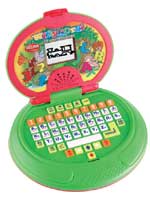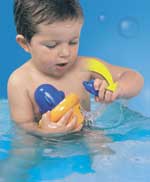|
|||
| Introduction | |||
| Childhood games and toys | |||
| CHILDHOOD, GAMES AND TOYS Childhood, games and toys relate each other, and in the historical-social development of mankind they have the same origin. That is why it is impossible to separate them.
At the very beginning, when the primitive people subsisted only on what they were able to find, when they were nomads, children used to take part (from the moment they were able to walk independently) in the common tasks of subsistence so, childhood, as we understand it today, did not exist. Little by little, men and women started settling down and leaving nomadic life behind; agriculture made human beings stay in definite places. In that moment children still had to collaborate in the productive process, so they were given the appropriate instruments to work with. And although those instruments were small ones they still were not toys, but work tools in a reduced scale; the knife cut, the mallet hit..., so they were small reproductions of the real objects. As time went by and labor activity became more complex, stocks allowed people to have a better level of life. This had great repercussions in the development of mankind, as people were able to spend time doing things that had nothing to do with the productive process. This constituted a socializing process linked to psychic development, which is more and more advanced. And what happened with children then? They couldn’t participate in the labor activity because it was very complex. So men created objects very similar to the real ones; now they are not smaller replicas of the real objects, but things to "practice" actions, to "do as if...", to exercise the function designed for that object and that children will have to carry out when they became adults. This was the beginning of the toy; it was only a reproduction of a real object, but only the function of that real object is printed on it, but not its real structure. Thus, toys reflected the design and the objective of the real things.
This created the necessity of a preparatory stage in the individual development, in which children could train and exercise for what they will need for their future life. It is in this moment when childhood becomes a period for that preparation. Throughout those years, children are going to use the toys specially created for them. They are going to perform through them the actions and roles they will carry out when they grow. So play appears as a reproduction of the real life, adapted to the psychic, motor and physic possibilities of the children. In this way childhood, play and toys are born at the same time in the process of development of man and they are going to characterize the first preparation phase of the productive action that children have to have when they reach adult age. So childhood, play and toys are products of the social development and they are social because of their origin, their content and their meaning. We can state that childhood has a progressive social development by focussing on its progressive extension. There are historical evidences that talk about how childhood took only a few years at the very beginning. That was in the Middle Age. As society gets more and more complex, childhood starts being more considered in a wider way up to now when it is extended to adolescence, and sometimes, even to youth.
Toys represent the essence of childhood, as well as games. As childhood has expanded, games have enlarged their conception. They are products of the social activity so they reflect the development level of such society. As any material or spiritual product created by human beings, games and toys show the historical and social development of mankind. The concepts of childhood and play, as well as the characteristics of the toys, change as time goes by, as society is modified. Nowadays, technology has invaded our daily life and children are attracted strongly by it, so play and toys are entering more and more in its activities and knowledge fields. Movements and noises have always attracted children. At once, a baby discovers the world by moving his/her arm, pushing or pulling objects. He/she listens to the different noises and sounds. Progressively he/she starts to understand different phenomena, so now he/she is able to interact with objects. It is in this moment when the fascination towards electronic objects is born, because babies associate the pleasure of action with them. Children express their interests and motivations and discover proprieties and relations through action and experimentation. The essential activity of a child is play. It is the source of learning and it stimulates actions, reflections and expressions. Children investigate and know the world around them, people, animals, plants and even their possibilities and limitations, through games. They are the instruments that allow children to structure, understand and learn about their world. The high pleasure and educational potential contained by games and toys has to be used to stimulate children’s capacities. There are many games and activities that develop in children different visual, motive, logic, graphic, social and hearing abilities and increase their intelligence. |
||||||||||||||


